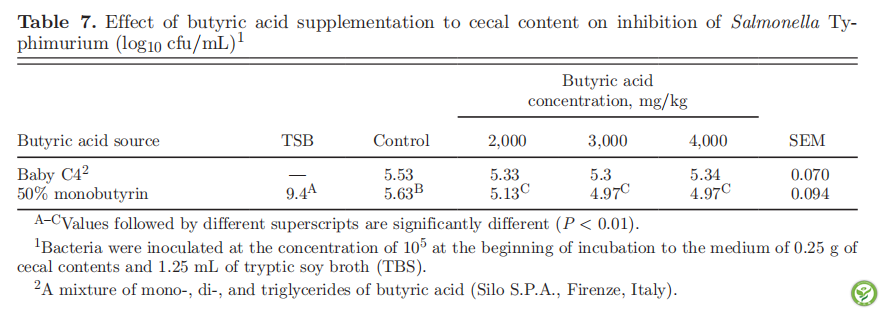原标题:丁酸甘油酯对鼠伤寒沙门氏菌和产气荚膜梭菌的抗菌作用
Antimicrobial activity of butyrate glycerides toward Salmonella Typhimurium and Clostridium perfringens
作者: H. Namkung ,* H. Yu ,† J. Gong ,† and S. Leeson 1
* Department of Animal and Poultry Science, University of Guelph, Guelph, Ontario Canada N1G 2W1; and † Food Research Program, Agriculture and Agri-Food Canada, Guelph, Ontario, Canada N1G 5C9
来源:2011 Poultry Science 90 :2217–2222
DOI: 10.3382/ps.2011-01498
翻译:肠动力研究院 梁琦
【摘要】本文研究了正丁酸及其衍生物对鼠伤寒沙门氏菌和产气荚膜梭菌的抗菌活性。将不同浓度(250-7000mg/kg)的正丁酸及其衍生物(单丁酸甘油酯和由单丁酸甘油酯,二丁酸甘油酯和三丁酸甘油酯组成混合物)加入含有鼠伤寒沙门氏菌或产气荚膜梭菌的培养基中。试验在两种细菌浓度(105 cfu/mL和107 cfu/mL)和两种接种环境(需氧或厌氧)下检测丁酸对产气荚膜梭菌的抗菌活性。实验观察到正丁酸对鼠伤寒沙门氏菌最有效的抗菌活性为:正丁酸浓度为1500mg/kg时有90%的抑制率。尽管丁酸甘油酯对鼠伤寒沙门氏菌的抑制作用最小,但将脂肪酶添加到由单丁酸、二丁酸和三丁酸甘油酯组成的混合物中却能显著增加这些衍生物的抗菌活性(P <0.01)。与接种较高初始浓度(107)相比,当接种中等初始浓度(105)时,丁酸及其衍生物对产气荚膜梭菌的抗菌活性较高。有氧条件下接种较低浓度的产气荚膜梭菌(105)时,添加浓度为2000mg/kg的丁酸甘油酯的抑制率均>90%;而厌氧条件下,添加浓度为3000mg/kg的单丁酸甘油酯却只有一半对产气荚膜梭菌保持>90%的抑菌活性。单丁酸甘油酯对产气荚膜梭菌的抑菌效果是:50%单丁酸甘油酯组显著高于100%单丁酸甘油酯组(P < 0.01)。在含有肠内容物的培养基中,丁酸衍生物的混合物组或50%单丁酸甘油酯组能够显著降低产气荚膜梭菌的浓度(P<0.01),而在含有成熟鸡盲肠内容物的培养基中,仅50%单丁酸甘油酯组能够显著降低鼠伤寒沙门氏菌的浓度(P <0.01)。研究结果表明:正丁酸和50%单丁酸甘油酯可用于预防鼠伤寒沙门氏菌或产气荚膜梭菌感染家禽。
【关键词】肉鸡;微生物学;产气荚膜梭菌;鼠伤寒沙门氏菌
以下是实验中相关图表
表1:体外条件下,丁酸和丁酸甘油酯对鼠伤寒沙门氏菌生长抑制百分率的影响 
表2:体外条件下,丁酸和丁酸甘油酯对产气荚膜梭菌(有氧接种浓度为107 cfu / mL)
生长抑制百分比的影响
表3:体外条件下,丁酸和丁酸甘油酯对产气荚膜梭菌(有氧接种浓度为105 cfu / mL)
生长抑制百分比的影响
表4:体外条件下,丁酸和丁酸甘油酯对产气荚膜梭菌(厌氧接种浓度为105 cfu / mL)
生长抑制百分比的影响
表5:添加抑制鼠伤寒沙门氏菌的丁酸的胰蛋白酶大豆肉汤培养基的pH值 
表6: 添加抑制产气荚膜梭菌的丁酸的胰蛋白酶大豆肉汤培养基的pH值
表7:添加到盲肠内容物中的丁酸对鼠伤寒沙门氏菌(log10 CFU/ mL)的抑制作用

表8:添加到蛋鸡肠道内容物中的丁酸对产气荚膜梭菌(log10CFU/ mL)的抑制作用

Conclusion
丁酸甘油酯为小肠的生长发育提供了新的递送系统,并很好的展现了其控制肠道病原体的潜力。除此外,单丁酸甘油酯还具有水溶性等附加优点,因此可将其用于农场以控制病原体感染不同日龄的家禽。
Abstract
The antimicrobial activities of n-butyric acid and its derivatives against Salmonella Typhimurium and Clostridium perfringens were studied. n-Butyric acid and its derivatives (monobutyrin and a mixture of mono-, di-, and tri-glycerides of butyric acid) were added at different concentrations (ranging from 250 to 7,000 mg/kg to a media inoculated with either Salmonella Typhimurium or C. perfringens. The antimicrobial activity of butyric acid against C. perfringens was measured at 2 bacterium concentrations and 2 inoculations involving ambient aerobic or anaerobic conditions. The most effective antimicrobial activity for Salmonella Typhimurium was observed with n-butyric acid, with 90% inhibition rate at a concentration of 1,500 mg/kg. Although minimal inhibition for Salmonella Typhimurium was observed with butyric acid glycerides, lipase addition to a mixture of mono-, di-, and triglycerides of butyric acid increased (P < 0.01) antimicrobial activity of these derivatives. Antimicrobial activity of butyric acid and its derivative against C. perfringens was higher when using a moderate initial inoculation concentration (105) compared with a higher initial concentration (107) of this bacterium. At a lower inoculation of C. perfringens (105), >90% inhibition rate by all acid glycerides was observed with prior aerobic inoculation at 2,000 mg/kg, whereas using anaerobic inoculation, only 50% monobutyrin maintained >90% inhibitory effect at 3,000 mg/kg. The antimicrobial effect of monobutyrin against C. perfringens was generally higher (P < 0.01) for 50% monobutyrin than for 100% monobutyrin. Either a mixture of butyric acid derivatives or 50% monobutyrin decreased (P < 0.01) C. perfringens in a media containing intestinal contents whereas only 50% monobutyrin decreased (P < 0.01) Salmonella Typhimurium within a media containing cecal contents from mature Leghorns. These results show that n-butyric acid and 50% monobutyrin could be used to control Salmonella Typhimurium or C. perfringens in poultry species.
Key words: broiler , microbiology , Clostridium , Salmonella
Conclusion
Butyrate glycerides offer a novel delivery system to the small intestine and provide potential for control over intestinal pathogens. Butyrate monoglyceride has the added advantage of being water soluble and therefore has application on farm to control pathogens of various targeted bird ages.
如您需原文,请联系本文作者和出版方,或请垂询肠动力研究院。本网站发布的所有资料将尽最大可能注明出处、作者及日期,如无意中侵犯了您的知识产权,请来信及时告知,我们将立即予以删除。
All information released by the WeChat Official Account will do its best to indicate the source, author and date. If we inadvertently infringe on your intellectual property, please inform us in time and we will delete it immediately.







